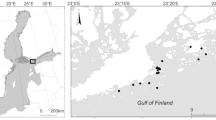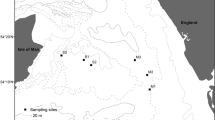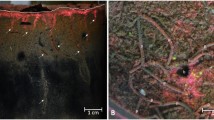Abstract
Species are often grouped according to their biological or functional traits to better understand their contribution to ecosystem functioning. However, it is becoming clear that a single species can perform different roles in different habitats. Austrohelice crassa, a burrow-building mud crab shifts its primary bioturbational role to that of a vertical mixer in non-cohesive sediments as frequent burrow collapse greatly enhances sediment reworking. We conducted in situ crab density manipulations in two sediment environments (a non-cohesive sand and a cohesive muddy-sand) to examine if the context-specific functional roles were linked to changes in solute fluxes across the sediment–water interface. Across both habitats, we show that A. crassa regulated nutrient cycling, creating strong density driven effects on solute exchanges. Increasing crab density increased sediment O2 demand and the flux of NH4 + from the sediment, indicating much of the response was physiologically driven. Clear interactions between A. crassa and microphytobenthos were also detected in both habitats. Despite lowering microphyte standing stock through deposit feeding, A. crassa increased benthic primary production per unit of chlorophyll a. Our experiment also revealed important context-specific differences, most notably for NH4 + fluxes, which were higher where burrows and their associated microbial communities were most stable (muddy-sand). This study highlights the need to integrate interactions between organism behavior and habitat type into functional group studies to broaden conceptual frameworks and avoid oversimplification of highly complex organism–sediment interactions.



Similar content being viewed by others
References
Aller RC. 1994. Bioturbation and remineralization of sedimentary organic matter: effects of redox oscillation. Chem Geol 114:331–45.
Aller RC, Aller JY. 1998. The effect of biogenic irrigation intensity and solute exchange on diagenetic reaction rates in marine sediments. J Mar Res 56:905–36.
Aller RC, Yingst JY. 1978. Biochemistry of tube dwellings: a study of the sedentary polychaetes Amphirtite ornate (Leidy). J Mar Res 36:201–54.
Andersen FØ, Kristensen E. 1988. The influence of macrofauna on estuarine benthic community metabolism: a microcosm study. Mar Biol 99:591–603.
Arar E, Collins G. 1997. Method 445.0: in vitro determination of chlorophyll a and phaeophytin a. Marine and freshwater algae by fluorescence. Revision 1.2. Cincinnati (OH): US Environmental Protection Agency.
Asmus H, Asmus R. 1985. The importance of grazing food chain for energy flow and production in three intertidal sand bottom communities of the northern Wadden Sea. Helgol Mar Res 39:273–301.
Bonsdorff E, Pearson TH. 1999. Variation in the sublittoral macrozoobenthos of the Baltic Sea along environmental gradients: a functional-group approach. Austral Ecol 24:312–26.
Botto F, Iribarne O. 2000. Contrasting effects of two burrowing crabs (Chasmagnathus granulata and Uca uruguayensis) on sediment composition and transport in estuarine environments. Estuar Coast Shelf Sci 51:141–51.
Botto F, Valiela I, Iribarne O, Martinetto P, Alberti J. 2005. Impact of burrowing crabs on C and N sources, control, and transformations in sediments and food webs of SW Atlantic estuaries. Mar Ecol Prog Ser 293:155–64.
Braeckman V, Provoost P, Gribsholt B, VanGansbeke D, Middleburg JJ, Soetaert K, Vinx M, Vanaverbeke J. 2010. Role of macrofauna functional traits and density in biogeochemical fluxes and bioturbation. Mar Ecol Prog Ser 399:173–86.
Bremner J, Rogers SI, Frid CLJ. 2006. Matching biological traits to environmental conditions in marine benthic ecosystems. J Mar Syst 60:302–16.
D’Andrea AF, DeWitt TH. 2009. Geochemical engineering by the mud shrimp Upogebia pugettensis (Crustacea: Thalassinidae) in Yaquina bay, Oregon: density dependent effects on organic remineralization and nutrient cycling. Limnol Oceanogr 54:1911–32.
Davis MW, Lee HII. 1983. Recolonization of sediment-associated microalgae and effects of estuarine infauna on microalgal production. Mar Ecol Prog Ser 11:227–32.
Day P. 1965. Particle fractionation and particle-size analysis. In: Black CA et al., Eds. Methods of soil analysis part 1. Madison, WI: American Society of Agronomy. p 545–67.
Dean W. 1974. Determination of carbonate and organic matter in calcareous sediments and sedimentary rocks by loss on ignition: comparison with other methods. J Sediment Petrol 44:242–8.
Escapa M, Minkoff DR, Perillo GME, Iribarne O. 2007. Direct and indirect effects of burrowing crab Chasmagnathus granulatus activities on erosion of southwest Atlantic Sarcocornia-dominated marshes. Limnol Oceanogr 52:2340–9.
Escapa M, Perillo GME, Iribarne O. 2008. Sediment dynamics modulated by burrowing crab activities in contrasting SW Atlantic intertidal habitats. Estuar Coast Shelf Sci 80:365–73.
Falkowski P, Kiefer DA. 1985. Chlorophyll a fluorescence in phytoplankton: relationship to photosynthesis and biomass. J Plankton Res 7(5):715–31.
Gibbs MM, Ross AH, Downes MT. 2002. Nutrient cycling and fluxes in Beatrix Bay, Pelorus sound, New Zealand. N Z J Mar Fresh Water Res 36:675–97.
Gilbert F, Stora G, Bonin P. 1998. Influence of bioturbation on denitrification activity in Mediterranean coastal sediments: an in situ experimental approach. Mar Ecol Prog Ser 163:99–107.
Gilbert F, Aller RC, Hulth S. 2003. The influence of macrofaunal burrow spacing and diffusive scaling on sedimentary nitrification and denitrification: an experimental simulation and model approach. J Mar Res 61:101–25.
Graf G, Rosenberg R. 1997. Bioresuspension and biodeposition: a review. J Mar Syst 11:269–78.
Gutiérrez JL, Jones CG, Groffman PM, Findlay SEG, Iribarne OO, Ribeiro PD, Bruschetti CM. 2006. The contribution of crab burrow excavation to carbon availability in surficial salt-marsh sediments. Ecosystems 9:647–58.
Heip CHR, Goosen NK, Herman PMJ, Kromkamp J. 1995. Production and consumption of biological particles in temperate tidal estuaries. Oceanogr Mar Biol 33:1–149.
Henriksen K, Rasmussen MB, Jensen A. 1983. Effect of bioturbation on microbial nitrogen transformations in the sediment and fluxes of ammonium and nitrate to the overlaying water. Ecol Bull 35:193–205.
Hollertz K, Duchêne JC. 2001. Burrowing behaviour and sediment reworking in the heart urchin Brissopsis lyrifera Forbes (Spatangoida). Mar Biol 139:951–7.
Kemp WM, Sampou P, Caffrey J, Mayer M, Henriksen K, Boynton WR. 1990. Ammonium recycling versus denitrification in Chesapeake Bay sediments. Limnol Oceanogr 35:1545–63.
Kostka JE, Gribsholt B, Petrie E, Dalton D, Skelton H, Kristensen E. 2002. The rates and pathways of carbon oxidation in bioturbated saltmarsh sediments. Limnol Oceanogr 47:230–40.
Kristensen E. 1985. Oxygen and inorganic nitrogen exchange in a Nereis virens (Polychaeta) bioturbated sediment–water system. J Coast Res 1:109–16.
Kristensen E, Jensen MH, Andersen TK. 1985. The impact of polychaete (Nereis virens Sars) burrows on nitrification and nitrate reduction in estuarine sediments. J Exp Mar Biol Ecol 85:75–91.
Lee SY. 1998. Ecological role of grapsid crabs in mangrove ecosystems: a review. Mar Freshw Res 49:335–43.
Lohrer AM, Thrush SF, Gibbs MM. 2004. Bioturbators enhance ecosystem function through complex biogeochemical interactions. Nature 431:1092–5.
Lohrer AM, Thrush SF, Hunt L, Hancock N, Lundquist C. 2005. Rapid reworking of subtidal sediments by burrowing spatangoid urchins. J Exp Mar Biol Ecol 321:155–69.
Lohrer AM, Halliday NJ, Thrush SF, Hewitt JE, Rodil IF. 2010. Ecosystem functioning in a disturbance-recovery context: contribution of macrofauna to primary production and nutrient release on intertidal sandflats. J Exp Mar Biol Ecol 390:6–13.
Marinelli RL. 1992. Effects of polychaetes on silicate dynamics and fluxes in sediments: importance of species, animal activity and polychaete effects on benthic diatoms. J Mar Res 50:745–79.
Marinelli RL, Williams TJ. 2003. Evidence for density-dependent effects of infauna on sediment biogeochemistry and benthic–pelagic coupling in nearshore systems. Estuar Coast Shelf Sci 57:179–92.
Marinelli RL, Lovell CR, Wakeham SG, Ringelberg DB, White DC. 2002. Experimental investigation of the control of bacterial community composition in macrofaunal burrows. Mar Ecol Prog Ser 235:1–13.
McCraith BJ, Gardner LR, Wethey DS, Moore WS. 2003. The effect of fiddler crab burrowing on sediment mixing and radionuclide profiles along a topographic gradient in a southeastern salt marsh. J Mar Res 61:359–90.
Mermillod-Blondin F, Rosenberg R. 2006. Ecosystem engineering: the impact of bioturbation on biogeochemical processes in marine and freshwater benthic habitats. Aquat Sci 68:434–42.
Morrisey DJ. 1988. Differences in effects of grazing by deposit-feeders Hydrobia ulvae (Pennant) (Gastropoda: Prosobranchia) and Corophium arenarium Crawford (Amphipoda) on sediment microalgal populations. II. Quantitative effects. J Exp Mar Biol Ecol 118:43–53.
Needham HR, Pilditch CA, Lohrer AM, Thrush SF. 2010. Habitat dependence in the functional traits of Austrohelice crassa, a key bioturbating species. Mar Ecol Prog Ser 414:179–93.
Norling K, Rosenberg R, Hulth S, Gremare A, Bonsdorff E. 2007. Importance of functional biodiversity and species-specific traits of benthic fauna for ecosystem functions in marine sediment. Mar Ecol Prog Ser 332:11–23.
Paterson DM, Wiltshire KH, Miles A, Blackburn J, Davidson I, Yates MG, McGrorty S, Eastwood JA. 1998. Microbial mediation of spectral reflectance from intertidal cohesive sediments. Limnol Oceanogr 43(6):1207–21.
Peterson BJ, Heck KL Jr. 2001. Positive interactions between suspension-feeding bivalves and seagrass—a facultative mutualism. Mar Ecol Prog Ser 213:143–55.
Ray AJ, Aller RC. 1985. Physical irrigation of relict burrows: implications for sediment chemistry. Mar Geol 62:371–9.
Riisgård HU, Kamermans P. 2001. Switching between deposit and suspension feeding in coastal zoobenthos. In: Reise K, Ed. Ecological Comparisons of Sedimentary Shores. Ecological Studies, Vol. 151. Berlin: Springer-Verlag. p 73–100.
Rodil IF, Lohrer AM, Chiaroni LD, Hewitt JE, Thrush SF. 2011. Disturbance of sandflats by thin terrigenous sediment deposits: consequences for primary production and nutrient cycling. Ecol Appl 21:416–26.
Sandwell DR, Pilditch CA, Lohrer AM. 2009. Density dependent effects of an infaunal suspension-feeding bivalve (Austrovenus stutchburyi) on sandflat nutrient fluxes and microphytobenthic productivity. J Exp Mar Biol Ecol 373:16–25.
Sassa S, Watabe Y. 2008. Threshold, optimum and critical geoenvironmental conditions for burrowing activity of sand bubbler crab, Scopimera globosa. Mar Ecol Prog Ser 354:191–9.
Slomp CP, Malschaert JFP, Raaphorst WV. 1998. The role of adsorption in sediment–water exchange of phosphate in North Sea continental margin sediments. Limnol Oceanogr 43:832–46.
Snelgrove PVR. 1999. Getting to the bottom of marine biodiversity: sedimentary habitats. BioScience 49:129–38.
Suding KN, Lavorel S, Chapin FS, Cornelissen JHC, Diaz S, Garnier E, Goldberg D, Hooper DU, Jackson ST, Nava ML. 2008. Scaling environmental change through the community-level: a trait-based response-and-effect framework for plants. Glob Change Biol 14:1125–40.
Sundback K, Enoksson V, Granneli W, Petterson K. 1991. Influence of sublittoral microphytobenthos on the oxygen and nutrient flux between sediment and water: a laboratory continuous-flow study. Mar Ecol Prog Ser 74:263–79.
Sundback K, Miles A, Goransson E. 2000. Nitrogen fluxes, denitrification and the role of microphytobenthos in microtidal shallow-water sediments: an annual study. Mar Ecol Prog Ser 200:59–76.
Sundback K, Miles A, Hulth S, Pihl L, Engstrom P, Selander E, Svenson A. 2003. Importance of benthic nutrient regeneration during initiation of macroalgal blooms in shallow bays. Mar Ecol Prog Ser 246:115–26.
Tang M, Kristensen E. 2007. Impact of microphytobenthos and macroinfauna on temporal variation of benthic metabolism in shallow coastal sediments. J Exp Mar Biol Ecol 349:99–112.
Thrush SF, Hewitt JE, Norkko A, Cummings VJ, Funnell GA. 2003. Macrobenthic recovery processes following catastrophic sedimentation on estuarine sandflats. Ecol Appl 13:1433–55.
Thrush SF, Gray JS, Hewitt JE, Ugland KI. 2006. Prediction the effect of habitat homogenization in marine biodiversity. Ecol Appl 16:1636–42.
Trimmer M, Nedwell DB, Sivyer DB, Malcom SJ. 1998. Nitrogen fluxes through the lower estuary of the river Great Ouse, England: the role of the bottom sediments. Mar Ecol Prog Ser 163:109–24.
Volkenborn N, Polerecky L, Wethey DS, Woodin SA. 2010. Oscillatory porewater bioadvection in marine sediments induced by hydraulic activities of Arenicola marina. Limnol Oceanogr 55(3):1231–47.
Wang J, Zhang X, Jiang L, Bertness M, Fang C, Chen J, Hara T, Li B. 2010. Bioturbation of burrowing crabs promotes sediment turnover and carbon and nitrogen movements in an estuarine salt marsh. Ecosystems 13:586–99.
Webb AP, Eyre BD. 2004. The effect of natural populations of the burrowing and grazing soldier crab (Mictyris longicarpus) on sediment irrigation, benthic metabolism and nitrogen fluxes. J Exp Mar Biol Ecol 309:1–19.
Widdicombe S, Austen MC. 1998. Experimental evidence for the role of Brissopsis lyrifera (Forbes, 1841) as a critical species in the maintenance of benthic diversity and the modification of sediment chemistry. J Exp Mar Biol Ecol 228:241–55.
Williams B, Naylor E, Chatterton T. 1985. The activity patterns of New Zealand mud crabs under field and laboratory conditions. J Exp Mar Biol Ecol 89:269–82.
Williamson RB, Wilcock RJ, Wise BE, Pickmere SE. 1999. Effect of burrowing by the crab Helice crassa on chemistry of intertidal muddy sediments. Environ Toxicol Chem 18:2078–86.
Ysebaert T, Herman PMJ. 2002. Spatial and temporal variation in benthic macrofauna and relationships with environmental variables in an estuarine, intertidal soft-sediment environment. Mar Ecol Prog Ser 244:105–24.
Acknowledgments
We thank Dudley Bell, Luca Chiaroni, Branwen Hughes, Anna John, Hannah Jones, Deniz Özkundakci, Warrick Powrie, and Julia Simpson for field support and Kerry Allen, Scott Edhouse, Bruce Patty, and Jacinta Parenzee for laboratory assistance. The subject-matter editor Karen McGlathery and two anonymous reviewers provided constructive and insightful comments that greatly improved the manuscript. This research was supported by a NIWA PhD scholarship funded through the Foundation for Research, Science and Technology (FRST) project no. C01X0501.
Author information
Authors and Affiliations
Corresponding author
Additional information
Author’s contributions
HRN CAP AML and SFT conceived the study, HRN and AML conducted research and analyzed data, HRN wrote the paper with substantial editorial input from CAP, AML and SFT.
Electronic supplementary material
Below is the link to the electronic supplementary material.
Rights and permissions
About this article
Cite this article
Needham, H.R., Pilditch, C.A., Lohrer, A.M. et al. Context-Specific Bioturbation Mediates Changes to Ecosystem Functioning. Ecosystems 14, 1096–1109 (2011). https://doi.org/10.1007/s10021-011-9468-0
Received:
Accepted:
Published:
Issue Date:
DOI: https://doi.org/10.1007/s10021-011-9468-0




